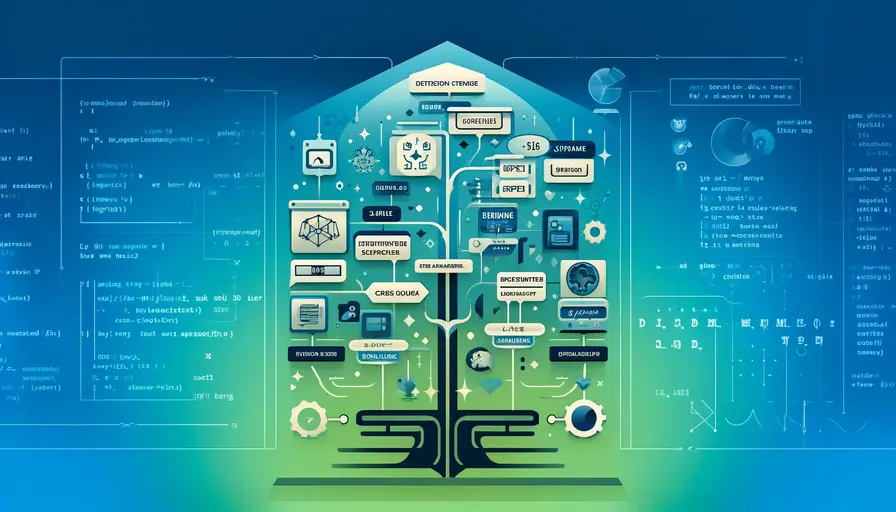A decision tree classifier is a versatile and powerful machine learning model used for classification tasks. In this guide, we will walk through the steps to build a decision tree classifier using scikit-learn, a popular Python library for machine learning. We will cover everything from understanding the problem, importing necessary libraries, loading and preparing the dataset, creating and fitting the classifier, making predictions, evaluating performance, tuning hyperparameters, and visualizing the decision tree.
Code Example for Decision Tree Classifier
Let’s start with a comprehensive code example that showcases how to build, train, and evaluate a decision tree classifier using scikit-learn.
# Importing necessary libraries
import numpy as np
import pandas as pd
from sklearn.model_selection import train_test_split
from sklearn.tree import DecisionTreeClassifier
from sklearn.metrics import accuracy_score, precision_score, recall_score, confusion_matrix, classification_report
from sklearn import tree
import matplotlib.pyplot as plt
# Load dataset
df = pd.read_csv('path_to_your_dataset.csv')
# Handling missing values (example: fill with mean)
df.fillna(df.mean(), inplace=True)
# Encoding categorical variables
df = pd.get_dummies(df)
# Splitting the dataset into features and target variable
X = df.drop('target_column', axis=1)
y = df['target_column']
# Splitting the data into training and testing sets
X_train, X_test, y_train, y_test = train_test_split(X, y, test_size=0.2, random_state=42)
# Creating an instance of the decision tree classifier
clf = DecisionTreeClassifier()
# Fitting the classifier to the training data
clf.fit(X_train, y_train)
# Predicting the target variable for the testing data
y_pred = clf.predict(X_test)
# Evaluating the performance of the classifier
accuracy = accuracy_score(y_test, y_pred)
precision = precision_score(y_test, y_pred, average='weighted')
recall = recall_score(y_test, y_pred, average='weighted')
print(f'Accuracy: {accuracy}')
print(f'Precision: {precision}')
print(f'Recall: {recall}')
print('Confusion Matrix:')
print(confusion_matrix(y_test, y_pred))
print('Classification Report:')
print(classification_report(y_test, y_pred))
# Visualizing the decision tree
plt.figure(figsize=(20,10))
tree.plot_tree(clf, filled=True, feature_names=X.columns, class_names=['class0', 'class1'])
plt.show()Understand the Problem You Want to Solve with a Decision Tree Classifier
Before diving into the code, it’s crucial to have a clear understanding of the problem you are trying to solve. Decision trees are used for classification problems where the goal is to assign categorical labels to samples based on input features. Typical applications include spam detection, disease diagnosis, and customer segmentation.
Import the Necessary Libraries in Python, Including Scikit-Learn
To implement a decision tree classifier, you will need several libraries. The most important ones are NumPy, Pandas, Matplotlib, and scikit-learn.
NumPy
NumPy is essential for numerical operations in Python. It provides support for arrays, matrices, and many mathematical functions.
import numpy as npPandas
Pandas is used for data manipulation and analysis. It provides data structures like DataFrame that make it easy to handle and clean data.
import pandas as pdMatplotlib
Matplotlib is a plotting library used for creating static, animated, and interactive visualizations in Python.
import matplotlib.pyplot as pltLoad Your Dataset into a Pandas DataFrame
Loading your dataset into a pandas DataFrame is the first step in data preparation. Pandas makes it easy to load, manipulate, and analyze data.
Handling Missing Values
Handling missing values is crucial as they can significantly impact the performance of your model. You can fill missing values with the mean, median, or mode, or use other imputation techniques.
df.fillna(df.mean(), inplace=True)Encoding Categorical Variables
If your dataset contains categorical variables, you need to encode them into numerical values. One common method is using one-hot encoding.
df = pd.get_dummies(df)Splitting the Dataset
Split the dataset into features (X) and target variable (y). The target variable is the column you want to predict.
X = df.drop('target_column', axis=1)
y = df['target_column']Prepare Your Data by Separating the Features and the Target Variable
Separating the features and target variable helps in organizing the data for training and testing the model. Ensure that the features (X) and target (y) are correctly defined and preprocessed.
Split Your Data into Training and Testing Sets
Splitting the data into training and testing sets is essential for evaluating the model’s performance on unseen data. Typically, an 80-20 or 70-30 split is used.
from sklearn.model_selection import train_test_split
X_train, X_test, y_train, y_test = train_test_split(X, y, test_size=0.2, random_state=42)Create an Instance of the Decision Tree Classifier
Creating an instance of the DecisionTreeClassifier from scikit-learn is straightforward. This instance can then be used to fit the model to the training data.
Available Parameters for the Decision Tree Classifier
The DecisionTreeClassifier has several parameters that you can tune to improve performance, such as criterion, max_depth, min_samples_split, and min_samples_leaf.
from sklearn.tree import DecisionTreeClassifier
clf = DecisionTreeClassifier(criterion='gini', max_depth=None, min_samples_split=2, min_samples_leaf=1)Fit the Classifier to Your Training Data
Fit the classifier to your training data using the fit method. This trains the model on the provided data.
clf.fit(X_train, y_train)Predict the Target Variable for Your Testing Data
Use the trained classifier to make predictions on the testing data. The predict method generates the predicted labels.
y_pred = clf.predict(X_test)Evaluate the Performance of Your Classifier Using Metrics Such as Accuracy, Precision, and Recall
Evaluating the model’s performance is crucial to understand how well it generalizes to new data. Use metrics such as accuracy, precision, recall, and the confusion matrix.
from sklearn.metrics import accuracy_score, precision_score, recall_score, confusion_matrix, classification_report
accuracy = accuracy_score(y_test, y_pred)
precision = precision_score(y_test, y_pred, average='weighted')
recall = recall_score(y_test, y_pred, average='weighted')
print(f'Accuracy: {accuracy}')
print(f'Precision: {precision}')
print(f'Recall: {recall}')
print('Confusion Matrix:')
print(confusion_matrix(y_test, y_pred))
print('Classification Report:')
print(classification_report(y_test, y_pred))Tune the Hyperparameters of Your Decision Tree Classifier to Improve Its Performance
Hyperparameter tuning involves adjusting the parameters of the decision tree to improve its performance. This process can be done using techniques like grid search or random search.
Understanding Hyperparameters
Hyperparameters are settings that control the learning process. For a decision tree, these include max_depth, min_samples_split, min_samples_leaf, and criterion.
Tuning Hyperparameters
Use tools like GridSearchCV from scikit-learn to find the optimal hyperparameters.
from sklearn.model_selection import GridSearchCV
param_grid = {
'criterion': ['gini', 'entropy'],
'max_depth': [None, 10, 20, 30],
'min_samples_split': [2, 10, 20],
'min_samples_leaf': [1, 5, 10]
}
grid_search = GridSearchCV(DecisionTreeClassifier(), param_grid, cv=5, scoring='accuracy')
grid_search.fit(X_train, y_train)
print(f'Best parameters: {grid_search.best_params_}')
best_clf = grid_search.best_estimator_Visualize Your Decision Tree to Gain Insights into the Decision-Making Process
Visualizing the decision tree helps you understand the model’s decisions and the features it considers important.
import matplotlib.pyplot as plt
from sklearn import tree
plt.figure(figsize=(20,10))
tree.plot_tree(best_clf, filled=True, feature_names=X.columns, class_names=['class0', 'class1'])
plt.show()Use Your Trained Decision Tree Classifier to Make Predictions on New, Unseen Data
Once your model is trained and evaluated, you can use it to make predictions on new data.
new_data = pd.DataFrame({
# Provide the new data in the same format as the training data
})
new_predictions = best_clf.predict(new_data)
print(new_predictions)Building a decision tree classifier in scikit-learn involves several steps, from understanding the problem and preparing the data to training the model, evaluating its performance, tuning hyperparameters, and making predictions. By following these steps, you can harness the power of decision trees to solve complex classification problems effectively.


